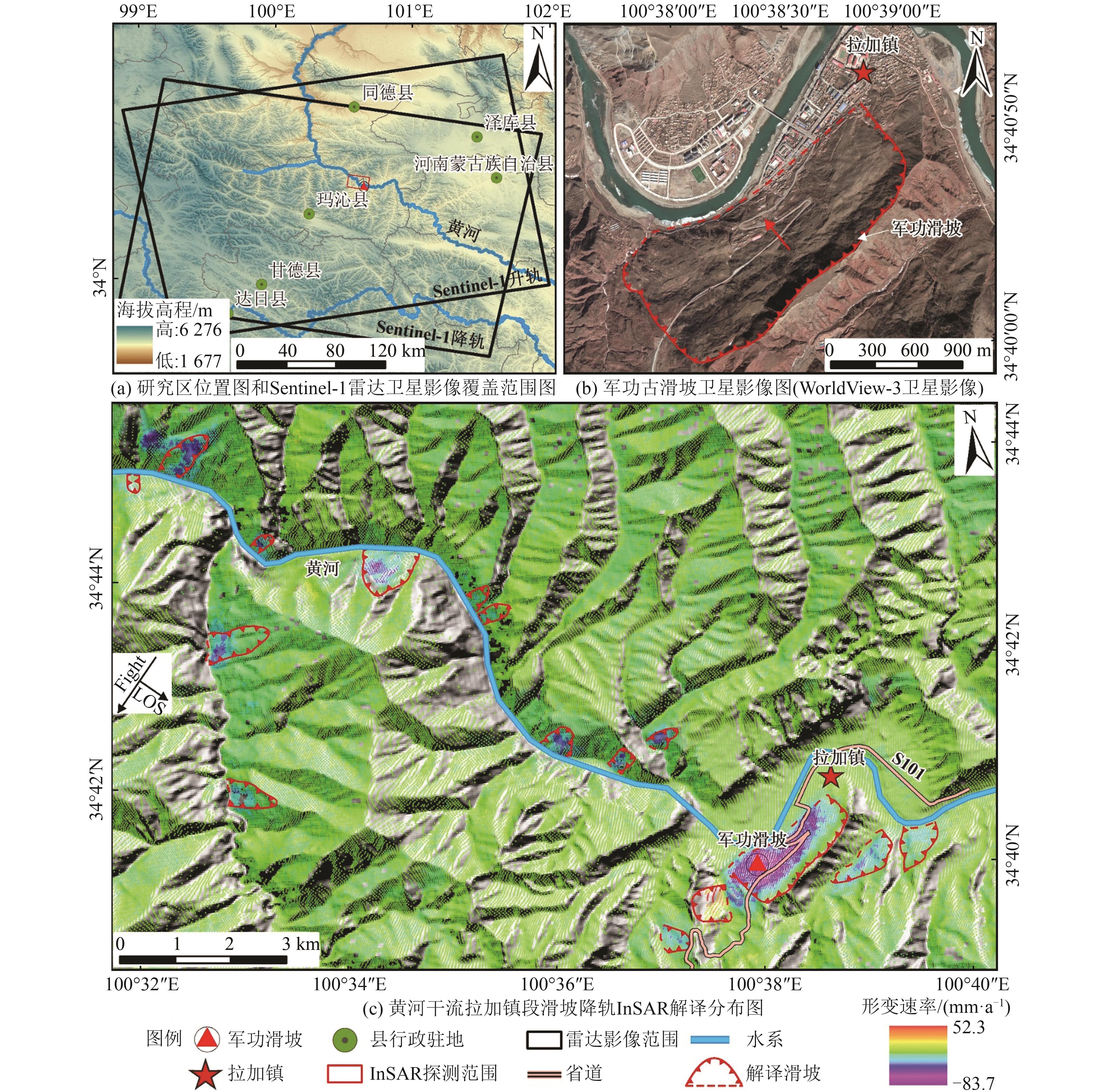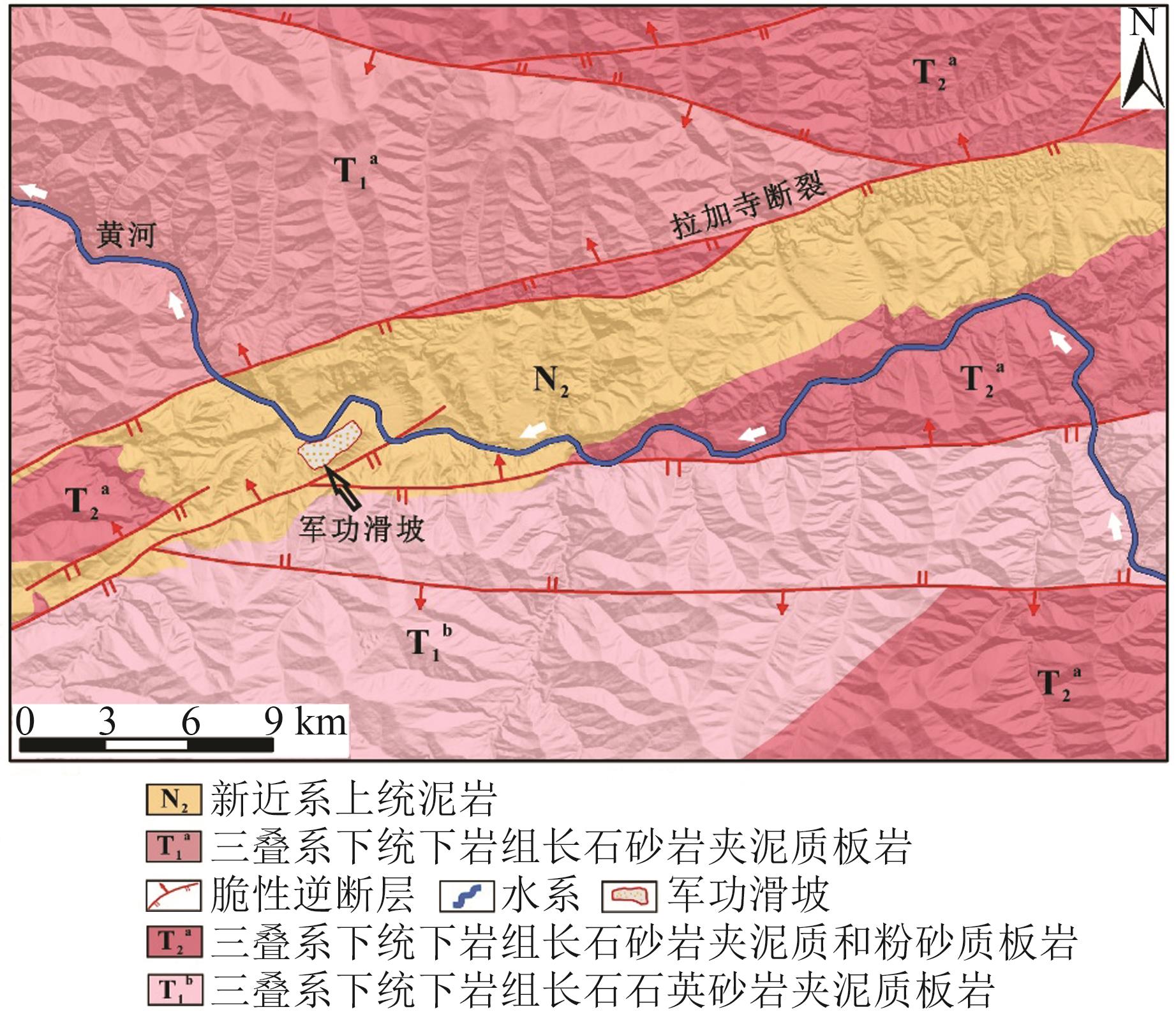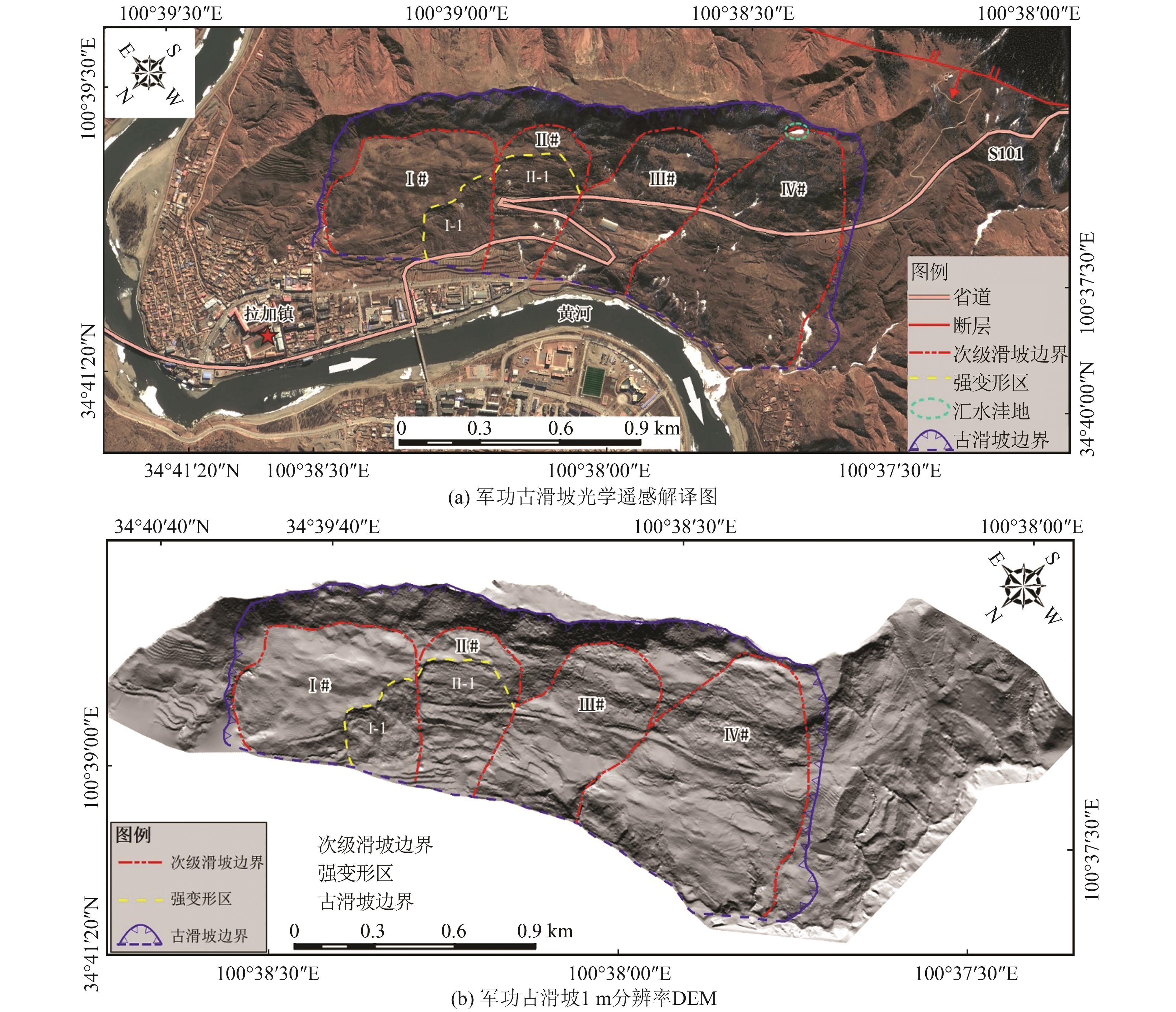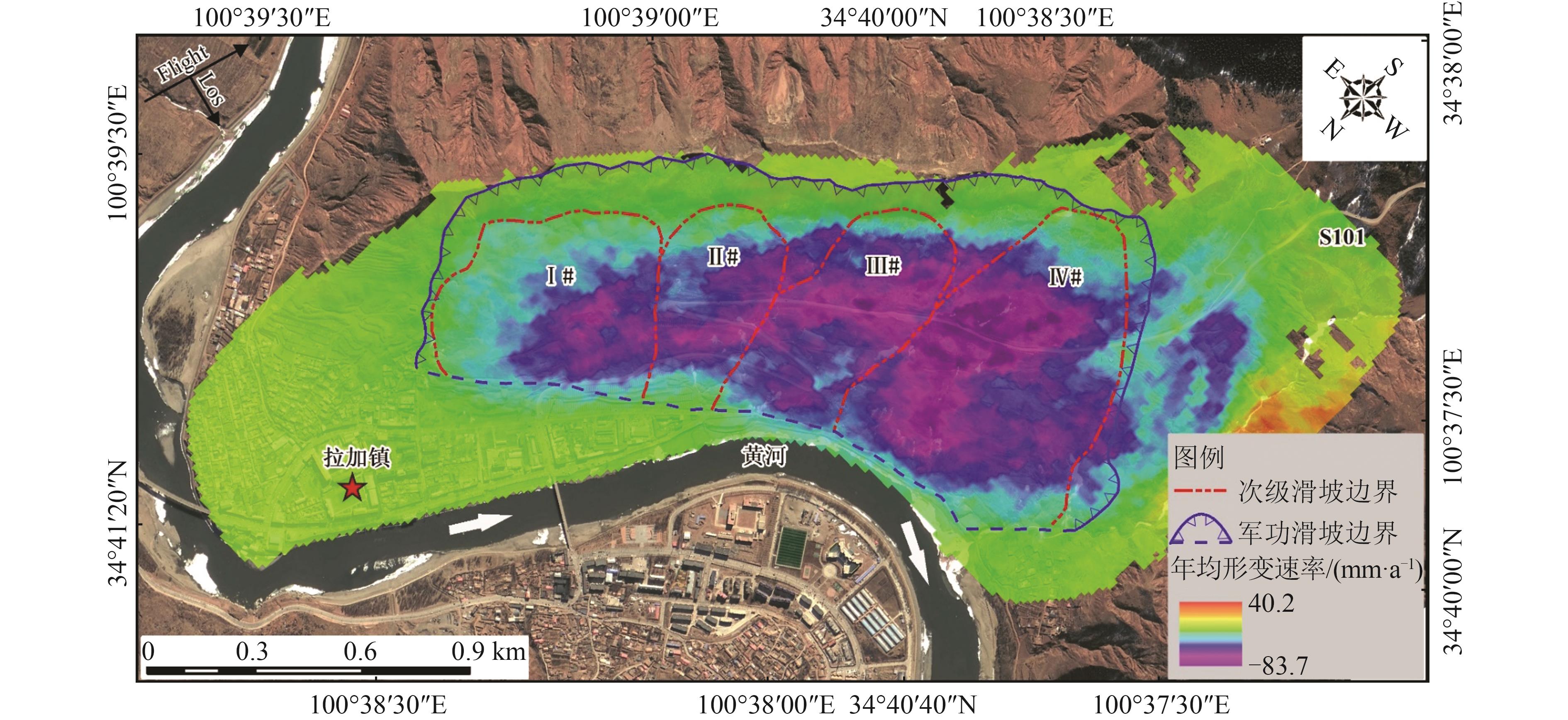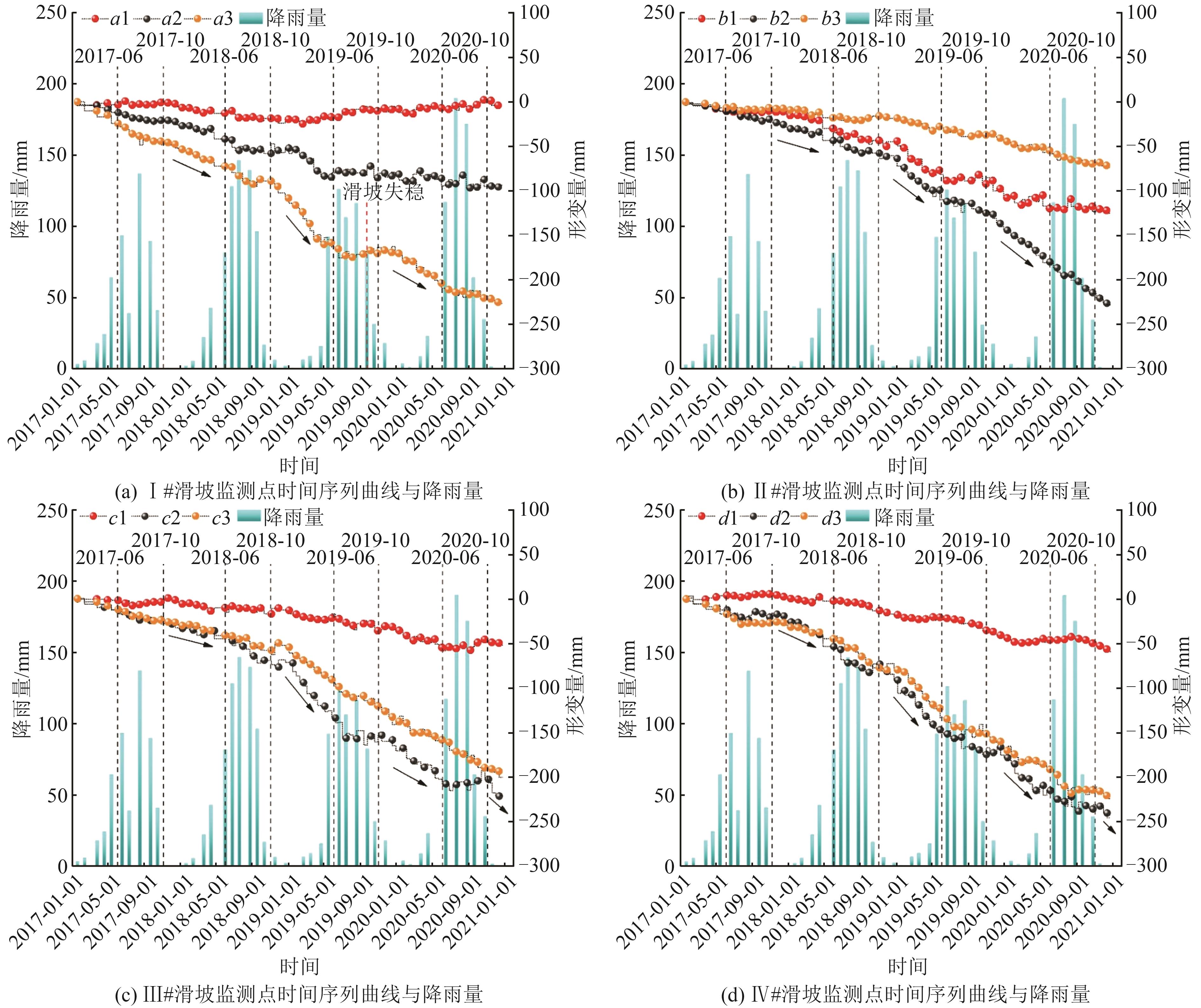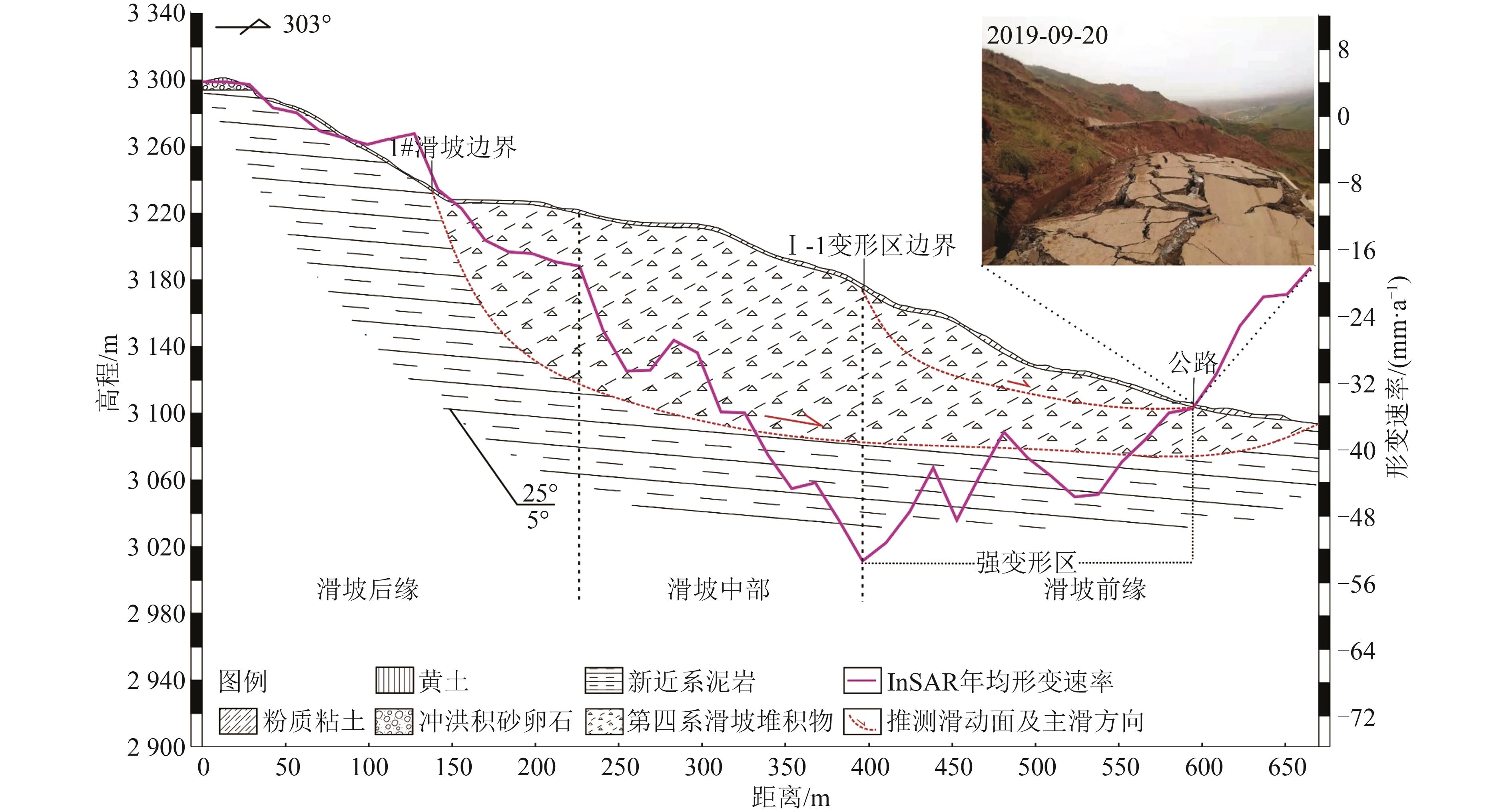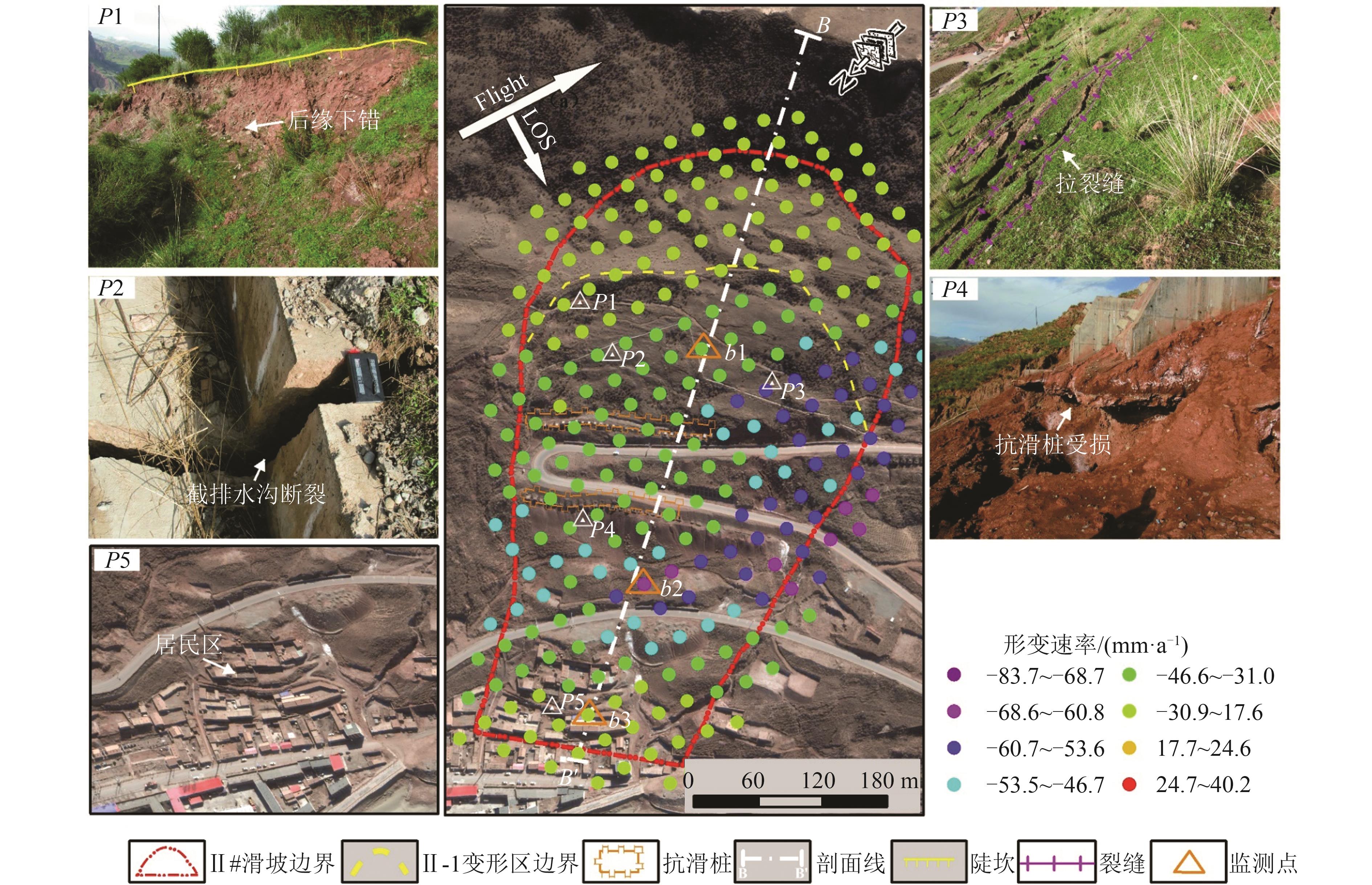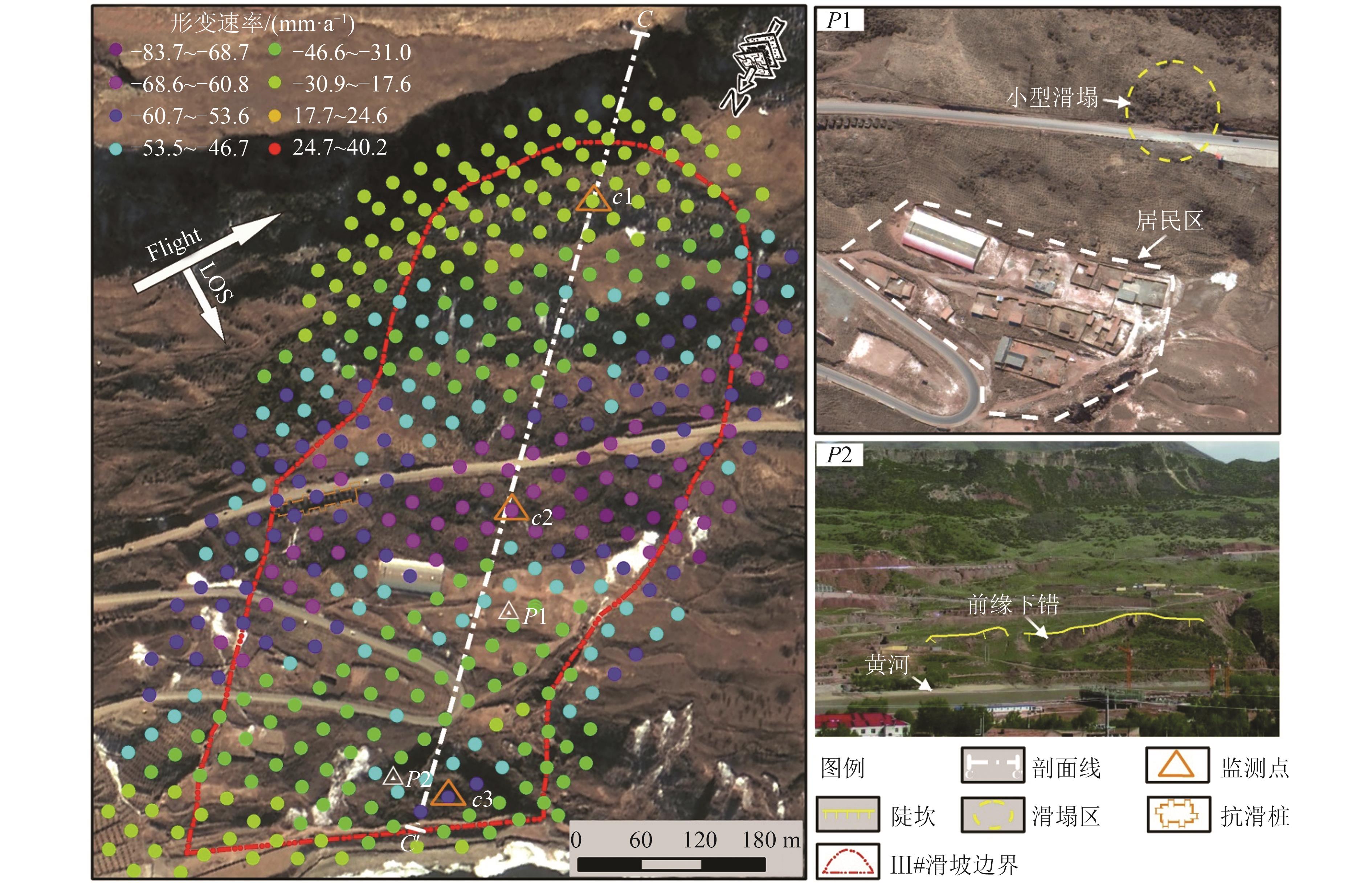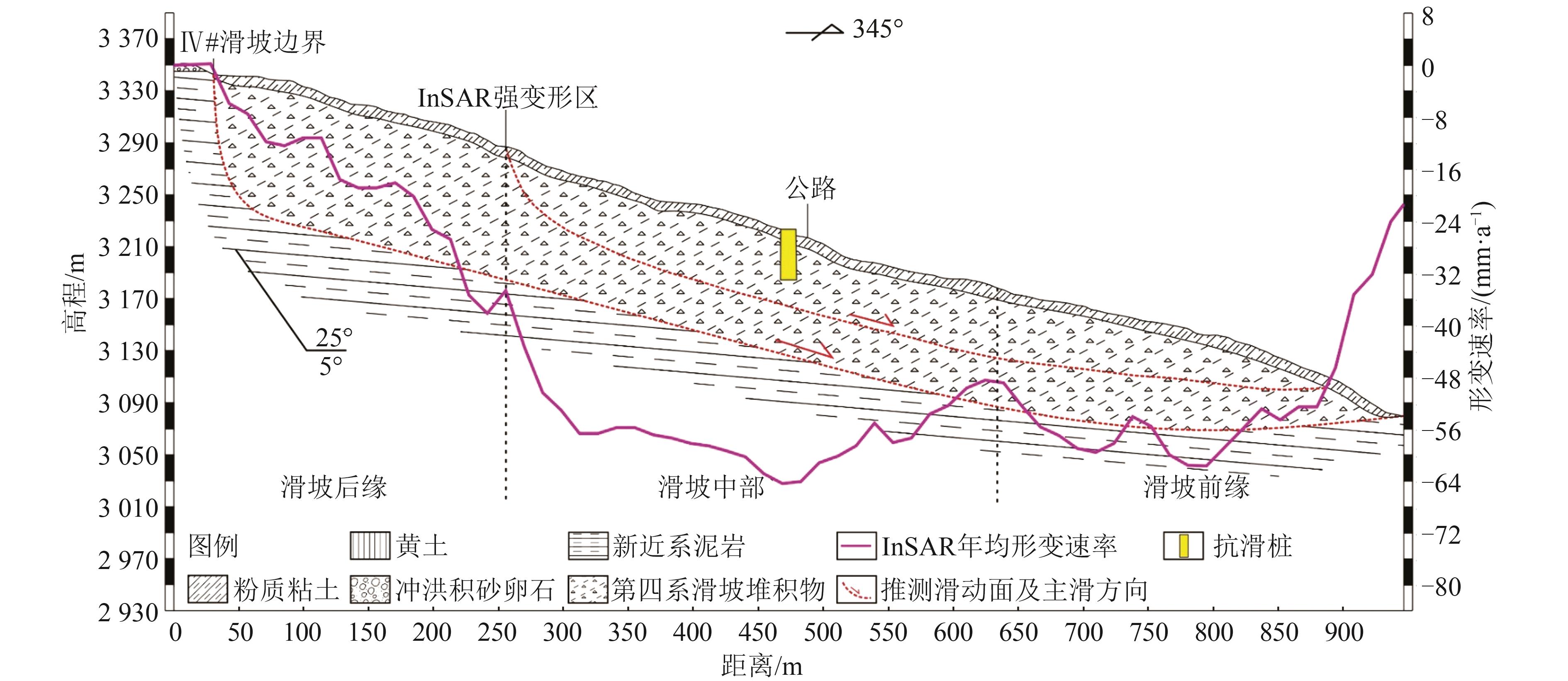Deformation Analysis of Jungong Ancient Landslide Based on SBAS-InSAR Technology in the Yellow River Mainstream
-
摘要:
2019-09-20,中国青海省玛沁县拉加镇军功古滑坡发生局部失稳,导致公路交通中断,严重威胁当地居民生命财产安全,亟需查明古滑坡的形变区和形变规律,为防治工程设计和监测预警提供参考。首先利用高分辨率卫星影像和数字高程模型数据并结合现场调查,基于滑坡形态特征和形变迹象对古滑坡进行分区;然后利用2017-01-2020-12的Sentinel-1雷达卫星降轨数据,基于小基线集合成孔径雷达干涉测量技术(small baseline subset interferometric synthetic aperture radar, SBAS-InSAR)对古滑坡的地表形变特征和形变规律进行分析。基于滑坡形态特征和变形迹象,将古滑坡分为4个次级滑坡区,SBAS-InSAR形变结果显示古滑坡整体处于持续的缓慢蠕滑状态。滑坡强变形区主要位于公路开挖段,人类活动对古滑坡稳定性扰动较大,滑坡强变形区形变速率与降雨具有较好的响应关系。虽然古滑坡局部已进行了抗滑桩等工程治理,但由于古滑坡存在多级滑面,已有抗滑桩深度不够,虽发挥了一定的抗滑作用,但未起到完全阻止滑坡整体蠕滑变形的作用,建议后续治理工程应利用钻探等勘察技术手段查明多级滑面深度后进行设计施工,并在强形变区安装裂缝计等现场实时监测预警设备,结合雷达卫星InSAR中长期监测,实现对该滑坡点、面结合的监测预警。
-
关键词:
- 军功滑坡 /
- 古滑坡复活 /
- 滑坡分区 /
- 形变规律 /
- 小基线集合成孔径雷达干涉测量 /
-
Abstract:ObjectivesOn September 20, 2019, the Jungong ancient landslide in Lajia Town, Maqin County, Qinghai Province, China suffered a local failure, which led to the interruption of traffic and seriously threatened the safety of local residents' lives and properties. It is urgent to find out the deformation area and deformation law of the ancient landslide, and to provide the support for prevention and control enginee-ring design, monitoring and early warning.
MethodsFirst, using high-resolution satellite images, digital elevation model data and combined with field investigations, the ancient landslide were zoned based on landslide morphological characteristics and signs of deformations; further, Sentinel-1 radar satellite descending data from January 2017 to December 2020 were used to analyze the surface deformation characte-ristics and deformation patterns of the ancient landslide based on small baseline subset interferometric synthetic aperture radar technology (SBAS-InSAR).
ResultsBased on the morphological characteristics and deformation signs of the landslide, the ancient landslide was divided into four sub-areas. The SBAS-InSAR results show that the ancient landslide is in a continuous slow creeping state. The strong deformation area of the landslide is mainly located in the road excavation section. Human activities greatly disturb the stability of the ancient landslide. The deformation rate of the strong deformation area of the landslide has a good relationship with rainfall.
ConclusionsAlthough the ancient landslide has been partially treated with anti-slide piles and other projects, the ancient landslide has multi-level sliding surfaces, and the depth of the existing anti-slide piles is not enough. Although the ancient landslide has played a certain role in anti-slide, it has not completely prevented the creep deformation of the landslide. It is suggested that the subsequent treatment projects should use drilling and other exploration techniques to find out the depth of the multi-level sliding surfaces before designing, and installing on-site real-time monitoring and early warning equipment such as crack meters in the strongly deformed areas. Combined with the medium and long-term monitoring of radar satellite InSAR, a point-surface monitoring and early warning system could be realized.
-
作为最为广泛使用的电离层经验模型之一,国际参考电离层模型(international reference ionosphere, IRI)对电离层研究和应用具有十分重要的意义[1]。IRI模型利用了垂测仪、非相干散射雷达、卫星观测及探空火箭数据,可以输出任意指定时间和经纬度的60~2 000 km的电子密度和总电子含量(total electron content, TEC)等多种电离层参数信息[2]。自1972年以来,随着电离层观测数据的积累、观测技术的革新和建模方法的改进,IRI模型已发布了多个版本,目前最新版本为IRI-2016 [3-4]。
峰值密度NmF2和峰值高度hmF2是表征电子密度廓线形态的重要参量。对于NmF2的计算,IRI-2016模型中包含IRI_CCIR和IRI_URSI两种模型选项。对于hmF2的计算,在旧版本模型使用的IRI_CCIR hmF2模型的基础上,IRI-2016模型中另外新增了IRI_AMTB和IRI_Shubin两种模型选项。hmF2的IRI_CCIR模型是基于1954—1958年全球分布的约150个垂测仪观测资料,利用hmF2与参数M(3 000)F2的强相关关系由M(3 000)F2计算得到。其中,M(3 000)F2为3 000 km高度处最大可用频率和F2层临界频率(foF2)的比值。这种间接计算hmF2的方法有诸多缺陷。IRI-2016模型中新增的两种计算hmF2的模型选项直接对hmF2进行建模,不依赖M(3 000)F2。其中,IRI_AMTB模型是根据全球分布的26个垂测仪(其中包括中国区域的武汉站、安阳站和三亚站)在1998—2006年的hmF2观测值,纯粹利用地基垂测仪观测值进行建模[5];IRI_Shubin模型的建立则使用了挑战性小卫星有效载荷(Challenging Minisatellite Payload,CHAMP)、重力恢复与气候实验(Gravity Recovery and Climate Experiment,GRACE)和气象、电离层和气候卫星联合观测系统(Constellation Observing System for Meteorology, Ionosphere and Climate,COSMIC)3个掩星任务的观测资料以及分布全球的62个垂测仪于1987—2012年的观测数据[6]。
COSMIC由美国国防部和中国台湾地区联合研制并于2006-04-15发射升空,在掩星观测任务中具有里程碑的意义[7]。COSMIC由6颗低轨卫星组成,轨道高度在800 km左右,轨道倾角为72°,并配备能够接收GPS信号的接收机。掩星事件发生时,GPS信号穿过电离层时受电子密度影响而发生折射,产生附加相位延迟。在信号直线传播和球对称假设等前提下,由传播路径上的总电子含量使用Abel积分变换方法可得到电子密度廓线。COSMIC掩星反演结果已经得到了多种独立观测手段的验证[8-10]。
中国区域(70°E~140°E,15°N~55°N)跨越中低纬地区,电离层变化幅度较大。文献[11]利用中国区域的4个垂测仪台站对IRI-2016模型在中国区域的性能进行了评估,但只能对垂测仪台站周围的电离层特征进行验证分析。COSMIC掩星观测具有全球覆盖、高精度、垂直分辨率高等特点,可用于对IRI-2016模型在整个中国区域的表现进行分析。本文的研究内容包括使用2008—2014年的COSMIC掩星数据对地磁平静条件下IRI-2016模型在中国区域的性能进行验证,并对IRI-2016模型在中国区域使用时不同NmF2和hmF2模型选项的输出结果进行统计分析,以确定IRI-2016模型在中国区域输出值的最优选项。
1 数据与模型
1.1 COSMIC掩星数据
COSMIC掩星二级产品“ionPrf”数据可从COSMIC数据存档与分析中心(COSMIC Data Analysis and Archive Center, CDAAC)的网站http://cdaac-www.cosmic.ucar.edu下载得到。该数据包含了掩星事件发生的时间、位置、NmF2、hmF2和电子密度廓线等信息。在分析地磁平静条件下IRI模型的表现时,需要先剔除3 h ap指数大于15的时间段的COSMIC掩星数据[8]。另一方面,尽管CDAAC在反演电子密度廓线时采取了一定的质量检核措施,但通过其检核的产品中仍然存在问题廓线[8]。文献[12]提出根据顶部电离层电子密度廓线的斜率和电子密度波动的平均偏差(mean deviation, MD)来剔除这些问题廓线。本文选择COSMIC电子密度廓线的标准为在420~490 km的斜率小于-0.02;平均偏差不超过1.5。此外,峰值高度hmF2范围应在200~500 km之间。
1.2 IRI-2016模型
IRI-2016模型输出值可从http://irimodel.org/网站获取。该模型中计算NmF2的选项包括IRI_CCIR模型和IRI_URSI模型。其中,IRI_URSI模型为推荐选项。计算峰值高度hmF2的选项包括原有的IRI_CCIR模型以及新增的IRI_AMTB模型和IRI_Shubin模型。其中,IRI_AMTB模型为推荐选项。模型的输入参数包括经纬度和时间。由于掩星观测具有水平漂移,本文选用COSMIC掩星观测的F2层峰值高度处的经纬度和发生时刻作为输入量,通过控制模型选项得到不同选项下输出的NmF2和hmF2。图 1(a)、1(b)分别为当地时间(local time, LT)2018-02-03T13:35和2008-02-08T23:46的COSMIC掩星电子密度廓线和IRI-2016模型不同选项下输出结果的比较图。可以看出,COSMIC电子密度廓线和IRI-2016模型不同选项以及选项之间的输出结果存在着明显差异。
1.3 F10.7指数
F10.7指数是指10.7 cm(2 800 MHz)波长的太阳辐射通量,单位为sfu,与太阳黑子数之间有强相关性,能很好地表征太阳活动强度。图 2是F10.7指数的月均值在第24太阳活动周2008—2014年期间的变化。可以看出,2008—2010年为太阳活动低年,尤其是2008、2009年,太阳活动达到了极低的水平;之后太阳活动水平逐渐提高,在2011—2014年太阳活动维持在较高水平,为太阳活动高年。
2 结果分析
2.1 IRI-2016模型在中国区域的性能分析
为了了解IRI-2016模型在中国区域的表现,首先采用模型推荐的选项计算NmF2和hmF2,将结果与COSMIC掩星观测进行比较。图 3为2008年和2014年COSMIC掩星观测与IRI-2016模型输出的峰值密度NmF2与峰值高度hmF2的散点图。其中,红色实线代表COSMIC观测值等于IRI预测值,黑色虚线代表使用最小二乘方法得到的拟合线,R和S分别表示两种方法得到的相关系数和拟合线斜率。由图 3(a)和3(b)可以看出,尽管在太阳活动低年2008年和太阳活动高年2014年,COSMIC掩星观测和IRI模型输出的NmF2相关系数非常接近(分别为0.86和0.87),但在2014年数据对较为均匀地围绕红色实线分布,且拟合线和等值线非常接近,斜率高达0.90。而在2008年,数据对较为分散,且较多的数据对分布在等值线下侧,拟合直线与等值线之间存在较大偏差。拟合直线的斜率(0.70)表明在太阳活动低年2008年,相较于COSMIC掩星观测值,IRI-2016模型明显高估了NmF2。与峰值密度NmF2情形类似,图 3(c)和图 3(d)表明, 在2014年IRI-2016模型峰值高度hmF2输出值与COSMIC掩星观测值更为接近,拟合直线几乎与等值线重合。而在2008年,拟合直线的斜率为0.76,远小于2014年的斜率0.97,说明2008年IRI-2016模型的hmF2输出值相对于COSMIC掩星观测存在明显高估。同时,由相关系数可以看出,无论在2008年还是2014年,NmF2的相关系数均高于hmF2,表明IRI-2016模型和COSMIC掩星观测输出的NmF2一致性优于hmF2。
为了进一步定量分析太阳活动低年和高年COSMIC掩星观测值和IRI-2016模型输出值的差异,定义了相对中误差绝对值的均值(mean absolute relative error,MARE)M,计算公式为:
$$ M=\frac{\mathop{\sum }^{}\left( \left| I-C \right|/C \right)}{N} $$ 式中,C表示由掩星数据反演的NmF2或者hmF2;I表示对应的由模型计算的NmF2或者hmF2;N为观测数据个数。
表 1给出了2008—2014年的NmF2和hmF2的MARE数值。可以看出,无论是NmF2还是hmF2,太阳活动低年(2008—2010年)的MARE均高于太阳活动高年(2011—2014年),在太阳活动极小年(2008—2009年),IRI-2016模型输出值与COSMIC掩星观测值的差异最大。
表 1 2008—2014年NmF2和hmF2的MARE/%Table 1. MARE of NmF2 and hmF2 During 2008―2014/%统计项 2008年 2009年 2010年 2011年 2012年 2013年 2014年 NmF2 31.112 2 31.481 8 27.836 7 26.7882 21.888 1 24.443 1 25.204 4 hmF2 11.689 0 11.944 2 9.747 9 8.460 8 7.071 9 8.021 6 7.344 6 因此,总体而言,对中国区域,无论是NmF2还是hmF2,以COSMIC掩星数据为参照,IRI-2016模型在太阳活动高年的表现都优于太阳活动低年。
2.2 太阳活动低年COSMIC掩星与IRI-2016模型峰值参数在中国区域的空间分布
为了进一步分析中国区域COSMIC掩星反演的峰值参数与IRI-2016模型输出值间的差异,对比了差异更为明显的太阳活动低年(2008—2010年)峰值参数的空间分布。考虑到电离层活跃水平,分析的时间段选为最具代表性的春秋季的中午时分(LT 12:00—14:00)。在本文中,季节的划分标准为:3月、4月、9月、10月为春秋季,5月—8月为夏季,11月、12月、1月和2月为冬季。图 4为2008—2010年春秋季中午(LT 12:00—14:00)由COSMIC掩星与IRI-2016模型得到的峰值参数NmF2与hmF2的均值在中国区域的空间分布。图 4(a)~4(d)显示,COSMIC掩星观测与IRI模型输出的峰值参数空间分布形态均反映出低纬地区电离层更为活跃,同时观测值与模型输出值之间存在明显差异。图 4(e)、4(g) 表明,对于NmF2,与COSMIC掩星反演结果对比,IRI模型输出值在15°N~30°N的低纬区域明显高估,相对偏差最高可达100%以上;而在30°N~55°N的中纬区域,IRI模型输出的NmF2普遍表现为低估。图 4(f)、4(h)表明,对于hmF2,情况恰恰相反:在30°N~55°N中纬区域,IRI模型的hmF2输出值普遍高于COSMIC观测值,而在15°N~30°N低纬区域,模型输出值普遍低于COSMIC观测值。由图 4(f)可见,在太阳活动低年,IRI-2016模型与COSMIC在中国区域得到的hmF2的绝对偏差一般不超过50 km。
2.3 IRI-2016模型峰值参数不同选项输出结果的比较分析
以上分析中所使用的IRI-2016模型输出值均基于模型的推荐选项得到。除了推荐选项,IRI-2016对NmF2和hmF2的计算均提供其他模型选项,而使用不同选项的模型输出结果存在差异。为了了解不同选项的模型在中国区域的表现,进一步以COSMIC掩星数据为参照,对IRI-2016模型中两种计算NmF2的选项(IRI_CCIR和IRI_URSI模型选项)和3种计算hmF2的选项(IRI_CCIR、IRI_AMTB和IRI_Shubin模型选项)的输出结果进行了比较。图 5给出了不同季节COSMIC掩星与IRI-2016模型两种不同选项得到的NmF2均值的日变化情况,其中图 5(a)~5(c)和图 5(d)~5(f)分别为太阳活动低年和高年的结果。统计中如果掩星事件发生时间与某一整点时刻相差不超过30 min,则该时刻的掩星数据和IRI模型输出结果被用于计算该整点时刻的平均值。可以看出,无论采用哪个选项,NmF2在约LT 04:00达到最小值,之后快速升高,在约LT 14:00达到全天最大值,之后逐渐下降。春秋季NmF2高于其他季节,电离层最为活跃。基于两种不同选项的IRI-2016模型输出值与COSMIC观测值均有相似的日变化趋势,但分别基于两种选项的模型输出结果之间存在一定差异。图 5(a)~5(c)表明采用两种选项的IRI-2016模型输出结果非常接近,但在中午时分,IRI_CCIR模型和IRI_URSI模型均高估了峰值密度,其中IRI_URSI的高估程度更严重。在春秋季和冬季,IRI_CCIR模型和IRI_URSI模型在LT 17:00—05:00则低估了峰值密度,其中IRI_URSI低估程度更严重。图 5(d)~5(f)与图 5(a)~5(c)的对比表明,随着太阳活动水平的增加,NmF2随之增大,但中午时分采用两种选项的IRI-2016模型输出值与COSMIC观测值之间的差异均有减小。特别是在太阳活动高年的夏季,IRI-2016模型和COSMIC观测值全天都符合得很好。而在春秋季LT 16:00—04:00,两种选项的IRI-2016模型输出值均小于COSMIC观测值,其中IRI_URSI的偏离度相对更大。
图 6给出了不同季节COSMIC掩星观测与IRI-2016模型3种不同选项输出的hmF2日变化情况。可以看出,3种选项对应的IRI-2016模型输出与COSMIC观测的hmF2呈现相似的日变化趋势,即在LT 06:00―07:00达到最小值,在LT 12:00达到小高峰,并在约LT 24:00LT达到全天最大值。在太阳活动低年,3种计算hmF2的模型选项中,IRI_Shubin模型输出值和COSMIC观测值最为接近,其他两种模型输出值相对于COSMIC观测值均存在高估。IRI_AMTB模型输出值相对于COSMIC观测值的高估现象更为突出,冬季最显著。与太阳活动低年相比较,在太阳活动高年,3种选项对应的hmF2模型输出值与COSMIC观测值的一致性均相对更好。但IRI_AMTB模型输出值在夜间的偏差仍较大。
3 讨论
本文以COSMIC掩星数据为参照,对IRI-2016模型在中国区域的电离层峰值参数NmF2和hmF2输出值随太阳活动强度、季节和昼夜的变化进行了对比分析。整体而言,模型输出值与COSMIC掩星观测值的相关性较高,但太阳活动低年的相关性低于太阳活动高年。两组数据拟合直线的斜率表明,IRI-2016模型输出值与COSMIC掩星观测值的一致性在太阳活动低年低于太阳活动高年。
文献[13]使用位于磁赤道附近的Jicamarca站垂测仪数据与IRI模型输出值进行验证分析,结果发现模型输出值与垂测仪观测值在太阳活动高年的相关性高于太阳活动低年,这与本文的研究结果一致。这主要是由于太阳活动低年,特别是2008年、2009年为太阳活动非寻常极小年,太阳活动水平极低且持续时间较长,IRI模型输出值会产生较大误差,甚至出现不合理的输出结果[3]。
太阳活动低年COSMIC掩星与IRI-2016模型峰值参数在中国区域的空间分布比较情况显示,虽然两者的空间分布形态基本一致,但仍存在明显差异。在15°N~30°N范围内,IRI-2016模型往往高估NmF2而低估hmF2。在30°N~55°N范围内,IRI-2016模型则存在低估NmF2而高估hmF2的现象。COSMIC掩星与IRI-2016模型之间的差异一方面是由于IRI-2016模型本身的误差,另一方面则是由于COSMIC掩星反演结果存在的误差。在球对称假设的前提下,COSMIC掩星反演的电子密度实际上是掩星切点附近整个掩星区域的平均值。因此,在电子密度梯度较大的区域,COSMIC掩星反演的电子密度与真实大气状态相比可能存在较大差异[14]。中国区域低纬度地区位于赤道电离层异常的驼峰区域附近,电子密度梯度很大,导致COSMIC反演的电子密度廓线相较于实际值可能存在较大偏差。
文献[15]使用中国区域位于同一经度带上的4个垂测仪台站(漠河站、北京站、武汉站和三亚站)数据对COSMIC掩星峰值参数进行了比较验证,发现在漠河站两者符合程度较高,但在武汉站和北京站中午时分COSMIC NmF2观测值高于垂测仪观测值,在三亚站中午时分COSMIC NmF2观测值低于垂测仪观测值。反演存在的误差可能使得在中纬度的武汉站(31.0°N,114.6°E)COSMIC反演的NmF2高于IRI-2016模型值,在低纬度的三亚站(18.3°N,109.6°E)COSMIC反演的NmF2低于IRI-2016模型值。文献[11]使用这4个垂测仪台站数据对IRI-2016模型计算hmF2的不同选项输出值结果进行比较分析,发现IRI-2016模型推荐的IRI_AMTB模型选项在4个台站均高估hmF2。本文结果也表明IRI-2016模型的hmF2输出值在30°N~55°N高于COSMIC掩星观测值。对于15°N~30°N范围,IRI-2016模型的hmF2输出值相对于掩星资料存在低估,原因可能是由于该范围位于赤道电离层异常驼峰附近,掩星反演的hmF2高于实际值[11]。
4 结语
本文对2008—2014年IRI-2016模型在中国区域的电离层峰值密度NmF2和峰值高度hmF2输出值与COSMIC掩星数据进行了对比,并对IRI-2016模型中计算这两个峰值参数的不同选项进行了比较分析。结论如下:
1)IRI-2016模型输出值与COSMIC掩星观测数据的一致性在太阳活动高年比太阳活动低年更好。模型NmF2输出值与COSMIC掩星观测值的相关性高于hmF2输出值与COSMIC掩星观测值的相关性。
2)在太阳活动低年春秋季的中午时段,与COSMIC掩星数据相比,IRI-2016模型在30°N~55°N对NmF2和hmF2分别存在低估和高估现象;在15°N~30°N区域内则恰恰相反。
3)以COSMIC掩星观测值为参照,IRI_CCIR模型和IRI_URSI模型均对NmF2在中午时分存在高估现象,该现象在太阳活动低年更为显著。而在春秋季的LT 17:00—04:00时间段,采用这两个模型选项得到的IRI-2016模型输出值均低于COSMIC观测值。
4)在太阳活动低年,无论任何季节,IRI_CCIR模型和IRI_AMTB模型的hmF2输出值均高于COSMIC掩星观测值,其中IRI_AMTB模型输出值相对于掩星观测的偏差更大,尤其是在冬季。IRI_Shubin模型的hmF2输出值与COSMIC观测值最为接近,即使在太阳活动高年,两者的偏差也小于其他两种模型。这表明COSMIC掩星资料在IRI_Shubin模型改进hmF2输出值中发挥了重要作用。
5)根据本文的研究结果,在中国区域采用IRI-2016计算NmF2和hmF2时,分别推荐使用IRI_CCIR和IRI_Shubin模型,而非官方推荐的IRI_URSI和IRI_AMTB模型。
http://ch.whu.edu.cn/cn/article/doi/10.13203/j.whugis20220196
-
-
[1] 张永双, 吴瑞安, 郭长宝, 等. 古滑坡复活问题研究进展与展望[J]. 地球科学进展, 2018, 33(7): 728-740. Zhang Yongshuang, Wu Ruian, Guo Changbao, et al. Research Progress and Prospect on Reactivation of Ancient Landslides[J]. Advances in Earth Science, 2018, 33(7): 728-740.
[2] 郭长宝, 倪嘉伟, 杨志华, 等. 川西大渡河泸定段大型古滑坡发育特征与稳定性评价[J]. 地质通报, 2021, 40(12): 1981-1991. Guo Changbao, Ni Jiawei, Yang Zhihua, et al. The Ancient Landslides Development Characteristics and Stability Evaluation Along the Luding Section, Dadu River, Western Sichuan Province[J]. Geological Bulletin of China, 2021, 40(12): 1981-1991.
[3] 郭长宝, 任三绍, 李雪, 等. 甘肃舟曲南峪江顶崖古滑坡发育特征与复活机理[J]. 现代地质, 2019, 33(1): 206-217. Guo Changbao, Ren Sanshao, Li Xue, et al. Development Characteristics and Reactivation Mechanism of the Jiangdingya Ancient Landslide in the Nanyu Town, Zhouqu County, Gansu Province[J]. Geoscience, 2019, 33(1): 206-217.
[4] 张海泉, 何文秀, 赵波, 等. 四川丹巴县“6.17” 梅龙沟泥石流-阿娘寨滑坡灾害链现场调查与监测分析[J]. 科学技术与工程, 2021, 21(29): 12481-12489. Zhang Haiquan, He Wenxiu, Zhao Bo, et al. Analysis of Field Investigation and Monitoring of “6.17” Meilong Valley Debris Flow-Aniangzhai Landslide Disaster Chain in Danba County, Sichuan Province[J]. Science Technology and Engineering, 2021, 21(29): 12481-12489.
[5] 陶国新, 洪文之. 滑坡对宁果公路的危害及防治对策[J]. 水文地质工程地质, 1995, 22(5): 29-31. Tao Guoxin, Hong Wenzhi. The Harm of Landslide to Ningguo Highway and Countermeasures[J]. Hydrogeology & Engineering Geology, 1995, 22(5): 29-31.
[6] 王秀凤, 王文祖. 西久公路军功1#滑坡变形机理分析[J]. 青海交通科技, 2008(6): 53-54. Wang Xiufeng, Wang Wenzu. Deformation Mechanism Analysis of Jungong 1# Landslide on Xijiu Highway[J]. Qinghai Transportation Science and Technology, 2008(6): 53-54.
[7] 程柯力, 白慧林, 方宏宇. 青海省军功滑坡变形破坏特征及机理研究[J]. 甘肃水利水电技术, 2021, 57(1): 45-51. Cheng Keli, Bai Huilin, Fang Hongyu. Study on Deformation and Failure Characteristics and Mechanism of Jungong Landslide in Qinghai Province[J]. Gansu Water Resources and Hydropower Technology, 2021, 57(1): 45-51.
[8] 戴可人, 卓冠晨, 许强, 等. 雷达干涉测量对甘肃南峪乡滑坡灾前二维形变追溯[J]. 武汉大学学报(信息科学版), 2019, 44(12): 1778-1786. Dai Keren, Zhuo Guanchen, Xu Qiang, et al. Tracing the Pre-failure Two-Dimensional Surface Displacements of Nanyu Landslide, Gansu Province with Radar Interferometry[J]. Geomatics and Information Science of Wuhan University, 2019, 44(12): 1778-1786.
[9] 冯文凯, 顿佳伟, 易小宇, 等. 基于SBAS-InSAR技术的金沙江流域沃达村巨型老滑坡形变分析[J]. 工程地质学报, 2020, 28(2): 384-393. Feng Wenkai, Jiawei Dun, Yi Xiaoyu, et al. Deformation Analysis of Woda Village Old Landslide in Jinsha River Basin Using SBAS-InSAR Technology[J]. Journal of Engineering Geology, 2020, 28(2): 384-393.
[10] 闫怡秋, 郭长宝, 张永双, 等. 基于SBAS-InSAR技术的西藏雄巴古滑坡变形特征[J]. 地质学报, 2021, 95(11): 3556-3570. Yan Yiqiu, Guo Changbao, Zhang Yongshuang, et al. Study of the Deformation Characteristics of the Xiongba Ancient Landslide Based on SBAS-InSAR Method, Xizang, China[J]. Acta Geologica Sinica, 2021, 95(11): 3556-3570.
[11] Dai C, Li W L, Wang D, et al. Active Landslide Detection Based on Sentinel-1 Data and InSAR Technology in Zhouqu County, Gansu Province, Northwest China[J]. Journal of Earth Science, 2021, 32(5): 1092-1103.
[12] 赵超英, 刘晓杰, 张勤, 等. 甘肃黑方台黄土滑坡InSAR识别、监测与失稳模式研究[J]. 武汉大学学报(信息科学版), 2019, 44(7): 996-1007. Zhao Chaoying, Liu Xiaojie, Zhang Qin, et al. Research on Loess Landslide Identification, Monitoring and Failure Mode with InSAR Technique in Heifangtai, Gansu[J]. Geomatics and Information Science of Wuhan University, 2019, 44(7): 996-1007.
[13] Dai K R, Li Z H, Xu Q, et al. Entering the Era of Earth Observation-based Landslide Warning Systems: A Novel and Exciting Framework[J]. IEEE Geoscience and Remote Sensing Magazine, 2020, 8(1): 136-153.
[14] Meng Q K, Li W L, Raspini F, et al. Time-Series Analysis of the Evolution of Large-Scale Loess Landslides Using InSAR and UAV Photogrammetry Techniques: A Case Study in Hongheyan, Gansu Province, Northwest China[J]. Landslides, 2021, 18(1): 251-265.
[15] 李为乐, 许强, 陆会燕, 等. 大型岩质滑坡形变历史回溯及其启示[J]. 武汉大学学报(信息科学版), 2019, 44(7): 1043-1053. Li Weile, Xu Qiang, Lu Huiyan, et al. Tracking the Deformation History of Large-Scale Rocky Landslides and Its Enlightenment[J]. Geomatics and Information Science of Wuhan University, 2019, 44(7): 1043-1053.
[16] 许强, 董秀军, 李为乐. 基于天-空-地一体化的重大地质灾害隐患早期识别与监测预警[J]. 武汉大学学报(信息科学版), 2019, 44(7): 957-966. Xu Qiang, Dong Xiujun, Li Weile. Integrated Space-Air-Ground Early Detection, Monitoring and Warning System for Potential Catastrophic Geohazards[J]. Geomatics and Information Science of Wuhan University, 2019, 44(7): 957-966.
[17] 刘筱怡, 杨志华, 郭长宝, 等. 基于SBAS-InSAR的鲜水河断裂带蠕滑型滑坡特征研究[J]. 现代地质, 2017, 31(5): 965-977. Liu Xiaoyi, Yang Zhihua, Guo Changbao, et al. Study of Slow-Moving Landslide Characteristics Based on the SBAS-InSAR in the Xianshuihe Fault Zone[J]. Geoscience, 2017, 31(5): 965-977.
[18] 莫玉娟, 吴洋, 刘学武. 基于SBAS技术的四川阿坝州小金县地表形变监测[J]. 测绘工程, 2018, 27(11): 46-50. Mo Yujuan, Wu Yang, Liu Xuewu. Monitoring the Ground Subsidence in Xiaojin County, Sichuan Province Based on Small Baseline Subset Technique[J]. Engineering of Surveying and Mapping, 2018, 27(11): 46-50.
[19] Yao J M, Lan H X, Li L P, et al. Characteristics of a Rapid Landsliding Area Along Jinsha River Revealed by Multi-temporal Remote Sensing and Its Risks to Sichuan-Tibet Railway[J]. Landslides, 2022, 19(3): 703-718.
[20] 陆会燕, 李为乐, 许强, 等. 光学遥感与InSAR结合的金沙江白格滑坡上下游滑坡隐患早期识别[J]. 武汉大学学报(信息科学版), 2019, 44(9): 1342-1354. Lu Huiyan, Li Weile, Xu Qiang, et al. Early Detection of Landslides in the Upstream and Downstream Areas of the Baige Landslide, the Jinsha River Based on Optical Remote Sensing and InSAR Technologies[J]. Geomatics and Information Science of Wuhan University, 2019, 44(9): 1342-1354.
[21] 林建国. G227线军功山段山体滑坡应急保通方案浅谈[J]. 公路交通科技(应用技术版), 2019, 15(10): 102-103. Lin Jianguo. Brief Discussion on Emergency Protection Plan for Landslides in Jungong Mountain Section of G227 Line [J]. Journal of Highway and Transportation Research and Development, 2019, 15(10): 102-103.
[22] 李小林, 马建青, 张婷婷, 等. 青海省特大滑坡分布特征及影响因素[J]. 城市地质, 2008, 3(4): 26-30. Li Xiaolin, Ma Jianqing, Zhang Tingting, et al. Analysis of the Distribution Features of Large Landslides in Qinghai and the Influencing Factors[J]. Urban Geology, 2008, 3(4): 26-30.
[23] 胡贵寿, 吴文新, 魏刚. 青海省特大型滑坡基本类型和发育分布特征[J]. 青海国土经略, 2008(6): 40-43. Hu Guishou, Wu Wenxin, Wei Gang. Analysis of the Distribution Features of Large Landslides in Qinghai and the Influencing Factors[J]. Management & Strategy of Qinghai Land & Resources, 2008(6): 40-43.
[24] 马还援,杨占祥,沈国英,等.青海省玛沁县拉加镇曲哇加萨(军功)滑坡勘察设计书[R].青海:青海省水文地质工程地质环境地质调查院工程分院,2013:6-17. Ma Huanyuan, Yang Zhanxiang, Shen Guoying, et al. Qinghai Province, Machin County, Lajia Town, Quwa Jiasa (Jungong) Landslide Survey and Design Book[R]. Qinghai: Qinghai Hydrogeology and Engineering Geology and Environgeology Survey Institute Engineering Branch, 2013:6-17.
[25] 戴可人. 融合新一代卫星SAR数据的地形与形变信息提取模型与方法[D]. 成都: 西南交通大学, 2017. Dai Keren. Integration of New Generation SAR Data for Extracting the Earth’s Surface Topography and Displacement: Methodology and Modelling[D].Chengdu: Southwest Jiaotong University, 2017.
[26] Shi X G, Yang C, Zhang L,et al. Mapping and Characterizing Displacements of Active Loess Slopes Along the Upstream Yellow River with Multi-temporal InSAR Datasets[J]. The Science of the Total Environment, 2019, 674: 200-210.
[27] 康亚. InSAR技术在西南山区滑坡探测与监测的应用[D]. 西安: 长安大学, 2016. Kang Ya. Landslide Detection and Monitoring over Southwestern Mountainous Area with InSAR[D].Xi’an: Chang'an University, 2016.
[28] 石固林, 徐浪, 张璇钰,等. 西山村滑坡时序形变的SBAS-InSAR监测[J]. 测绘科学, 2021, 46(2): 93-98. Shi Gulin, Xu Lang, Zhang Xuanyu, et al. Monitoring Time Series Deformation of Xishancun Landslide with SBAS-InSAR[J]. Science of Surveying and Mapping, 2021, 46(2): 93-98.
-
期刊类型引用(2)
1. 陆浩楠,叶世榕,张庆兰,夏朋飞,鄂盛龙. 利用COSMIC-1/2 IonPrf产品分析中国区域近15年电离层时空变化特征. 武汉大学学报(信息科学版). 2024(05): 765-774 .  百度学术
百度学术
2. 唐丝语,周春红,黄智,袁洪. 国际参考电离层模型输出参数峰值高度性能. 空间科学学报. 2021(06): 898-904 .  百度学术
百度学术
其他类型引用(2)






 下载:
下载:





